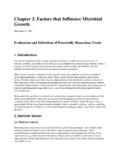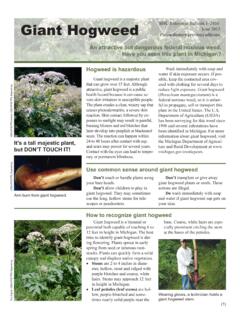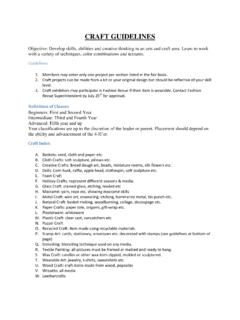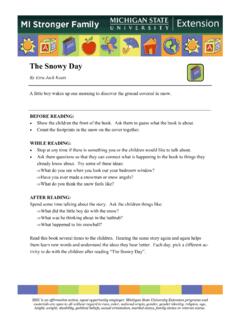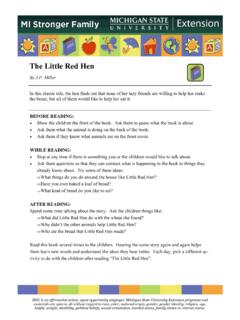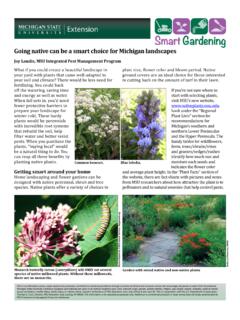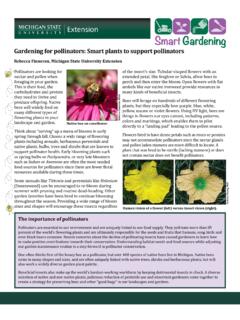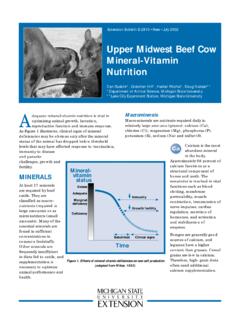Transcription of Dr. Hannah Mathers - MSU Extension
1 1 Herbicide Injury Dr. Hannah Mathers Herbicides are designed to kill undesirable plants. Unfortunately, desired plants can be injured or killed as well. In ornamentals, knowing how herbicide injury occurs and limiting its occurrence are imperative. Chemical damage to ornamental plants can be extremely expensive, and replacement costs are generally much higher than for other crops. A good understanding of how plants can be exposed to herbicides injury and the symptoms caused by a particular chemical, combined with a thorough investigation, will help pinpoint the sources of injury. Determining how plants were exposed to herbicides involves an examination of field patterns and/or symptoms on a group of plants, primarily.
2 However, injury symptoms on individual plants are also useful in determining exposure and the kind of chemical that was applied. Is the old growth affected more than the new growth? This is one of the most commonly asked questions in plant diagnostics. This question actually has five parts. First, was the injury at a point in time (contact) with no subsequent symptoms expressed in time or position (space) on the plant? Second, if a chemical is suspected, is toxicity or deficiency assumed? Third, if toxicity is thought to be the problem, is it caused by a nutrient or some other type of chemical? Fourth, did the injury progress in time and/or space (systemic)?
3 Fifth, if progressing, was it multidirectional (phloem) (symplastic movement) or only upward (xylem) (apoplastic movement)? Exposure There are four ways plants can be exposed to herbicide injury (Thompson and Ockley, 2006). 1. Drift or volatilization. Volatility is the ability to vaporize freely with the air. Some herbicides can evaporate and are lost in the form of gases or vapors. Some examples of volatile ornamental herbicides include Trifluralin, Dichlobenil, and Oxyfluorfen. Some herbicides such as 2, 4-D and atrazine, are not considered volatile compounds; however, they can evaporate over a period of time if hot and dry conditions prevail.
4 Volatile herbicides are lost more readily from moist soils. When soils are moist, immediate incorporation of a volatile chemical is extremely important. This type of injury is most likely when temperatures are above 80 F (Thompson and Ockley, 2006, when using herbicides subject to volatilization, when herbicides are not activated within their label guidelines (Table 1) and/ or spraying around plants that are very sensitive to the herbicide being applied, ex. spruce to glyphosate (Fig. 1). Herbicide drift can be reduced by using low water volumes, spraying at low pressures, using large droplet size nozzles, activating herbicides within the timeframes indicated on their labels (Table 1), and/or taking note of potential injury problems to surrounding plants before spraying.)
5 Note: the more volatile the chemical the shorter the period to activate (Table 1). 2 Table 1. Preemergence herbicide time of activation (in days) Chemical name Trade name Activation Isoxaben + Trifluralin Snapshot 3 Oryzalin + OxyfluorfenRout 1 DCPA Dacthal 4 Dichlobenil Casoron 1 EPTC Eptam 1 Isoxaben Gallery 21 Metolachlor Pennant 7 Napropamide Devrinol 3
6 Oryzalin Surflan 21 Oxadiazon Ronstar 1 Oxyfluorfen Goal 25 Pendimethalin Pendulum, others30 Prodiamine Barricade 14 Simzaine Princep 10 Trifluralin Treflan 2 Source: M. Halcomb, Field Nursery Weed Control. Agriculture Extension Service the University of Tennessee. 2002. (Additions by: H.)
7 Mathers ). Figure 1. Hot spots in field resulting from herbicide leaching and buildup. (Photo by: H. Mathers ) 2. Leaching or runoff. 3 Leaching in the context of herbicide injury refers to the downward movement of a substance in solution through the soil. The amount an herbicide will leach or run off depends on its solubility, the volume of water passing through the soil, the porosity of the soil or media, and the affinity of the media to adsorb the chemical. Groundwater contamination and herbicide runoff into recirculation ponds have increased nursery growers and landscape managers awareness of an herbicide s leaching potential.
8 Herbicides are given relative leaching potential indexes (RLPIs) (Stamps 2001); these are based on the organic carbon absorption coefficients and half-lives of the herbicide. They range from values of 3 (high potential to leach) (Simazine) (Table 2) to greater than 2,000 (low potential to leach) (Isoxaben) (Table 2). We need some movement of soil-applied herbicides into the soil in order for them to be absorbed by the weed roots; however, we don t want the herbicide to go off-site or move too deeply where it is ineffective, causes rooting damage to the desired plant or moves to the root zone of another plant (Thompson and Ockley, 2006).
9 Repeated herbicide leaching to a particular part of a field or landscape such as a low area can lead to what are known as hot spots (Fig. 2). Leaching or runoff injuries are most common when the wrong chemical is used for a particular site, too high a rate is applied and/or application is made at the wrong time. Table 2. Herbicide leaching and runoff potentials. Chemical Name Trade Name Application Method Leachate Potential Runoff Potential Benefin Balan Soil VL H Bensulide Betasan Soil M H Bentazon Basagran T/OFoliage M L DCPA Dacthal Soil L H Dichlobenil Casoron.
10 Other Soil M M EPTC Eptam Soil L L Fenoxaprop Acclaim Foliage VL M Fluazifop Fusilade Foliage VL M Glyphosate Roundup, Foliage VL H Isoxaben Gallery Soil L L Metolachlor Pennant Soil M M Napropamide Devrinol Soil L M Oryzalin Surflar Soil L L Oxadiazon Ronstar Soil L M Oxyfluorfen Goal Soil VL M Pendimethalin Pendulum.
